|
CT4SL
-
MY
MORSE KEYS COLLECTION |
|
HOME
|
PLEASE MAKE YOUR COMMENTS AND E-MAIL THEM TO ME.....HERE
|
#
131 ..... ARRL -
ADVANCED CODE
COURSE AND ARRL
CODE KIT |
|
A huge lot of Morse Code LEARNING Tapes, yet sealed on their original packedges.
Included is a Carrying Case (in mint condition!) that contains ARRL’s Introduction to Morse Code as well as 5 and 10 WPM tapes.
Also in this set are tapes from the Herman Smith Company of Up to 15WPM and 16-25 WPM.
Next is a set of 2 ARRL Set 2 (Still Factory Sealed) that covers 10 to 15 WPM.
And last is The ARRL Code Kit - two cassettes covering 5 to 13 WPM.
I know that cassette tapes may not be the most modern media at the present, and learning the Morse Code is not as critical as it once was, but some folks still have a cassette player and want to learn the code!
I will try to make some CD's or DVD's with the audio and turn them available for those HAM's that would like to learn morse code and make some QSO's. Feel free to ask them to my e-mail.
I purchase all those items together on one oction on ebay, from Warrior County, Alabama, USA.
|
|
#
132 .....
VIBROPLEX
"LIGHTENING BUG" |
A LITLE BIT IF
HISTORY:
BW
Lightening Bug
somewhere along
the line of the
Vibroplex
numbering system
went haywire,
maybe because
they wanted to
forget about the
Midget. The #6,
or Lightening
Bug, was
actually the
seventh
Vobroplex model.
It was
introduced in
about 1926 or
1927 and was
manufactured
until Vibroplex
moved to Maine
in 1979.
The Lightening
Bug was a
significant
departure from
previous models.
The frame was no
longer cast, but
was assembled
from two
triangular
plates and two
vertical
cylinders. The
damper assembly
was made from
two vertical
cylinders and a
flat cross-plate
with the damper
wheel suspended
from it. The
damper is called
the "M" damper.
Lastly, the
pendulum was a
thin flat bar,
and a cubical
speed weight was
used.
The first
Lightening Bugs
were available
with black
Japanned
(standard) and
nickel-plated
(optional)
bases. From
about 1929 to
1936 the
Lightening Bug,
Blue Racer and
Original were
available with
red, blue and
green base
finish. These
colored bugs
have been found
with both smooth
and crackle
finish. Some of
the
smooth-finish
bugs have the
color only on
the top of the
base and some
others have it
on the sides.
The colours
seems to have
been applied on
top of a
standard black
Japanned finish.
These colored
Vibroplexers are
quite scarce and
is currently no
agreement about
wich finishes
are authentic.
The standard
finish of the
Lightening Bug
was changed to
black crackle
about 1940 and
the grey crackle
in mid-Fifties.
The Deluxe
version of the
Lightening Bug
was popular, and
the WW2 Deluxe
version can also
be found. Just
before the
Lightening Bug
was discontinued
about 1980, but
some were made
with Sienna
Brown and beige
crackle base
finish.
During WW2, the
Lionel
Corporation made
exact copies of
the lightening
Bug for the Army
Signal Corps,
with a celuloid
Lionel
nameplate.
IDENTIFY
YOUR BUG NOW...!
(by
Randy Cole, KN6W)
|
 |
 |
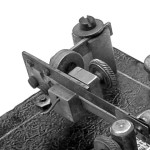 |
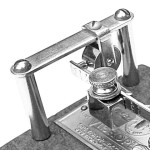 |
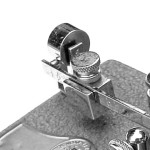 |
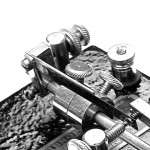 |
|
An " L " damper is made fron two cast pieces. The lower piece is shaped like the letter L. The upper cast piece is hinged to it and supports a damper wheel. |
A " U " damper is simply a casting in the shape of the letter U with a damper wheel attached to one side.
|
A " T " damper consists of a vertical post with a horizontar arm through it. The damper wheel is mounted to the end of the arm.
|
The " M " damper consists of a damper wheel hanging from a flat horizontal bar between two posts. The result is an assembly that looks like the letter M.
|
An " I " damper has a U-shaped piece of bent metal that holds up the damper wheel. The result is an assembly tha looks like the letter I.
|
A " SIMPLE " damper is one without the loosely-mounted wheel.
|
Finally, the next table will tell you which model you have:
| DAMPER TYPE |
3,5" BASE |
3" BASE |
2,5" BASE |
| " L " |
Original, double lever, presentation. |
Junior |
Blue Racer (later version). |
| " U " |
Wide-base #4 Blue Racer (special order). |
Wide-base #4 Blue Racer (special order) |
#4 Blue Racer. |
| " T " |
Patent 457, model x, a few originals and duble levers. |
None known |
A few #4 Blue Racers |
| " M " |
Lightening bug. |
None known |
None Known |
| " I " |
Champion. |
Zephyr |
None known |
| " SIMPLE " |
Improved model x. |
None known |
Midget on 2,5" base advertised but None Known. |
|
#
133 .... "NICOLA
TESLA" MORSE
KEYER |
The
JTs RTG-01 in an
interesting
straight key
with a bakelite
base, metal
cover, and
electronic
adjustments. The
mechanical parts
are nickel
plated and the
hardware is
stainless steel.
On the right
side is a 5 pin
din style
connector.
So
far, I've found
very little
information
about the JTs
RTG-01, other
than the fact
that it was used
by the Yugoslav
Military in the
mid twentieth
century and made
by NICOLA
TESLA,
Serbian-American
engineer born on
July 10, 1856,
in the village
of Smiljan in
Lika,
Yugoslavia.
The Man Who
Invented
Tomorrow. |
|
# 134 ..... "E. F. JOHNSON" SEMI-AUTO KEY (model 114-520) |
E. F. Johnson Company of Waseca, Minnesota, USA became the last manufacturer using the Speed-X name.
Johnson purchased Speed-X from Les Logan in 1947 and initially continued to produce basically the same type of keys. Eventually, a different weight design was used followed by a change in the fiber paddles to plastic. The last of the Johnson Speed-X bugs have chrome plating, different tags and other minor hardware changes. The bug shown is an early Johnson Speed-X Model 114-520 that is black crackel finish base and probably dates from early 50's.
This key was purchased to N2FQ, San José, California, USA.
|
|
# 135 ..... VIBROPLEX "CHAMPION" BUG |
This is a very nice (almoast 70 years old!) semi-automatic VIBROPLEX, model CHAMPION and s/n 143939, dated from 1945.
The CHAMPION was the “Chevrolet” of Vibroplex bugs. It used the assembled frame and flat pendulum of the Lightning Bug, but had a simplified damper assembly and lacked a circuit closer (shorting switch). It was the lowest-priced Vibroplex, handled well, and could send good code a bit slower than the round-pendulum models.
The “Champion” model was the “low-end” Vibroplex for many years, and featured a set of “Lightning Bug” parts on a standard-sized base, but with the simplified damper design of the“Zephyr” and the circuit-closing switch omitted for cost reduction. Discontinued sometime in the 1980s.
This key is fully functional and in excellent condition for it's age. The Champion was the only model never equipped with a circuit closer switch (to reduce cost).
I purchased this key at "Redbow Antiques and Collectibles" in Southeast Missouri, USA. 3.5"
The three different models of this kind of bugs presented by Randy Cole, KN6W:
|
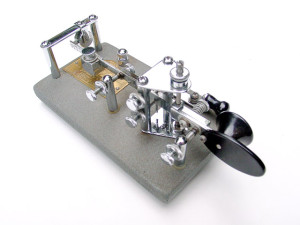 |
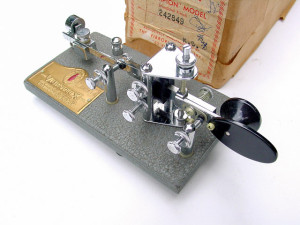 |
 |
The LIGHTENING BUG
(my #132) |
The CHAMPION
(note the circuit-closing omitted) |
The ZEPHYR
(my #136) |
|
# 136 ..... VIBROPLEX "ZEPHYR" BUG |
A pretty scarce and hard to find Vibroplex ZEPHYR s/n 190.261 dated from1955. The Zephyr was the only modern Vibroplex made on a three-inch base.
Basically a Zephyr is a Champion on a three-inch base with a circuit closer. The added circuit closer pushed up the cost, so a Zephyr cost about as much as an Original. Most people decided to just go ahead and buy the Original, so Zephyrs are fairly scarce these days.
This bug started been manufactured during 1939 (US Patent 2.187.351 shows a Zephyr) and stoped during 1958. Last Zephyr made has the s/n 201.928.
Not many were made so Zephyrs are pretty scarce. Made in standard black crackle finish and later in grey, discontinued in the 50's.
Purchased on St.Paul, Minnesota, USA. |
ZEPHYR models by KN6W (The Vibroplex Collectors Page):
|
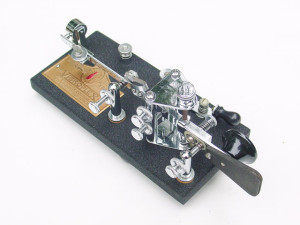
( S/N 190266 ) |
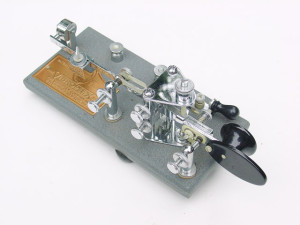
( S/N 198406 ) |
|
# 137 ..... C-MOS MEMORY KEYER ETM-4C |
Made in Germany during 1976 by Samson Margot at Osburg. It runs with 4x1,5volt dry batteries.
This memory keyer was purchased at Santa Barbara, Califórnia, USA.
|
some information about "C-MOS MEMORY KEYERS" |
|
ETM-1c |
 |
|
Country:
GERMANY
Manufacturer:
SAMSON MARGOT,
OSBURG
Year: 1983
Transistors: (5)
BC546,BC546,BC546,BC546,MPS-A92
Power voltage:
DRY BATTERIES /
4 X 1,5 VOLT
Dimensions
(WHD): 65 x 36 x 108 mm |
|
ETM-2b |
 |
#127 |
Country: GERMANY
Manufacturer: SAMSON MARGOT, OSBURG
Year: 1968
Transistors: (11)
Power voltage: DRY BATTERIES / 4 X 1,5 VOLT
Dimensions (WHD): 100 x 52 x 100 mm |
|
ETM-3 |
 |
#86 |
Country: GERMANY
Manufacturer: SAMSON MARGOT, OSBURG
Year: 1974-1977
Transistors: (4) BC238,MPS-A92,BC308,BC238
Power voltage: DRY BATTERIES / 4 X 1,5 VOLT
Dimensions (WHD): 100 x 52 x 150 mm |
|
ETM-3b |
 |
|
Country: GERMANY
Manufacturer: SAMSON MARGOT, OSBURG
Year: 1972
Transistors: (9) BC108,BC108,BC108,BC108,BC108,BC108,BC108,BC108,BSX45,SN7400,SN7410,SN7472,SN7473
Power voltage:
Alternating Current supply (AC) / 110; 220 Volt
Dimensions (WHD): 100 x 52 x 150 mm |
|
ETM-4c |
 |
#137 |
Country: GERMANY
Manufacturer: SAMSON MARGOT, OSBURG
Year: 1976
Transistors: (5): BC238,MPS-A92,BC308,BC328,BC328
Power voltage: DRY BATTERIES / 4 X 1,5 VOLT
Dimensions (WHD): 100 x 52 x 150 mm |
|
ETM-4m |
 |
|
Country: GERMANY
Manufacturer: SAMSON MARGOT, OSBURG
Year: 1974
Transistors: (5): BC238,MPS-A92,BC308,BC328,BC328
Power voltage:
Alternating Current supply (AC) / 220 Volt
Dimensions (WHD): 100 x 60 x 185 mm |
|
ETM-5c |
 |
|
Country: GERMANY
Manufacturer: SAMSON MARGOT, OSBURG
Year: 1983
Transistors: (3) BC546,BC546,BC546
Power voltage: DRY BATTERIES / 4 X 1,5 VOLT
Dimensions (WHD): 113 x 46 x 160 mm |
|
ETM-8c |
 |
#82 |
Country: GERMANY
Manufacturer: SAMSON MARGOT, OSBURG
Year: 1985
Transistors: (4) BC238,BC238,BC238,BC546
Power voltage: DRY BATTERIES / 4 X 1,5 VOLT
Dimensions (WHD): 113 x 45 x 160 mm |
|
ETM-9c |
 |
|
Country: GERMANY
Manufacturer: SAMSON MARGOT, OSBURG
Year: 1993
Transistors: (3) BC546,BC546,MPS-A93
Power voltage: DRY BATTERIES / 3 X 1,5 VOLT
Dimensions (WHD): 113 x 45 x 160 mm |
|
ETM-9c
X3 |
 |
|
Country: GERMANY
Manufacturer: SAMSON MARGOT, OSBURG
Year: 1993
Transistors: (4) BC546,BC546,BC546,MPS-A93
Power voltage: DRY BATTERIES / 3 X 1,5 VOLT
Dimensionas (WHD): 113 x 45 x 160 mm |
|
ETM-9c
COG |
 |
#142 |
Country: GERMANY
Manufacturer: SAMSON MARGOT, OSBURG
Year: 1993
Transistors: (3) BC546,BC546,MPS-A93
Power voltage: DRY BATTERIES / 3 X 1,5 VOLT
Dimensions (WHD): 106 x 36 x 160 mm |
|
ETM-9c
COG
x3 |
 |
|
Country: GERMANY
Manufacturer: SAMSON MARGOT, OSBURG
Year: 1993
Transistors: (4) BC546,BC546,BC546,MPS-A93
Power voltage: DRY BATTERIES / 3 X 1,5 VOLT
Dimensions (WHD): 65 x 36 x 108 mm |
|
#
138 .....
vibroplex square
racer magnetic
iambic key |
This Vibroplex Square Racer keys are a departure from the traditional Square Brass Racer.
These keys have a solid steel base, instead of brass, on four rubber feet, which anchor the Square Racer in the operation position. The same unique Racer magnetic design is retained on these keys. Each model has the famous Vibroplex brass logo plate, with a unique serial number pinned to the top of each base with stainless steel pins. The Square Racers are available in standard and deluxe models
Made by Vibroplex Company at
Mobile, Alabama, USA with s/n 106098 and with the red bug on the logo.
Purchased to CT1EWx
(Sérgio Lopes) |
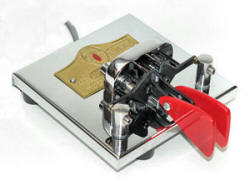
Square Racer Deluxe |
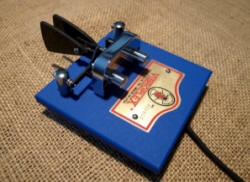
Square Racer Standard BLUE |
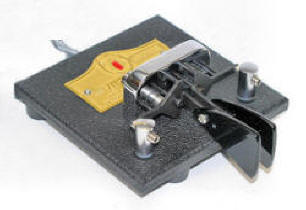
Square Racer Standard |

Brass Square Racer |
|
#
139 .....
WALTERS MORSE
KEY TYPE 51 |
|
A piece of
aviation history!
This very rare
key was fitted
to the first jet
airliner -
construction No.
G51 - the de
Havilland
Aircraft Co's
prototype DH106
Comet "G-ALVG"
belonging to
BOAC (British
Overseas Airways
Corporation),
first flight
flown by
Cunningham,
Hatfield on the
27th July 1949
Made
by Walters
Electrical
Manufacturing
Co. Ltd. Annotated
“12OZS”, “TYPE
51”, and
“10F5805-99-619-3832”.
This almost
certainly means
this was made
for the Air
Ministry or RAF
because of the
10F prefix. The
annotation
“5805-99-619-3832”
looks like a
Nato Stock
Number.
I am guessing
this is from
1950-1960’s
The key knob and
fingerplate look
to be ebonite,
as they have
faded slightly,
which would
probably date
the key to the
earlier part of
the period.
Ebonite
was generally
phased out
during WW2 and
replaced with
Bakelite.
The key comes in
what may be the
original box and
is in very good
condition.
It
was
purchased to
D.J.Holmes,
Scarborough, UK
|
|
#
140 .....
LABORATORY MORSE
KEY SWITCH |
|
Unusual laboratory type of spring loaded morse key. Annotated with the “PYE” sign at the top of the unit, and “W.G. PYE & Co. Ltd., CAMBRIDGE. Made in England.” at the bottom of the unit.
This unit is in very good condition.
This key was purchased to
D.J.Holmes, Scarborough, UK
|
[
TOP
]

|